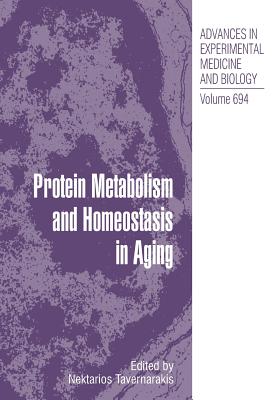You are here
Back to topProtein Metabolism and Homeostasis in Aging (Advances in Experimental Medicine and Biology #694) (Paperback)
$169.99
Usually Ships in 1-5 Days
Description
1. Synthesis, Modification and Turnover of Proteins during Aging Suresh I.S. Rattan Abstract Introduction Efficiency and Accuracy of Protein Synthesis during Aging Altered Protein Synthesis during Aging Post?Translational Modifications during Aging Protein Turnover during Aging Conclusion 2. Regulation of mRNA Translation as a Conserved Mechanism of Longevity Control Ranjana Mehta, Devon Chandler?Brown, Fresnida J. Ramos, Lara S. Shamieh and Matt Kaeberlein Abstract Introduction Genome Scale Longevity Screens in Yeast and Nematodes mRNA Translation is a Public Determinant of Longevity Is DR Mediated by Reduced mRNA Translation? Possible Mechanisms for How Translation Influences Aging Does mRNA Translation Modulate Aging in Mammals? Conclusion 3. Protein Synthesis and the Antagonistic Pleiotropy Hypothesis of Aging Pankaj Kapahi Abstract Evolution of Aging Insulin?Like Signaling (ILS) TOR Pathway Protein Synthesis Direct Screens to Identify Genes That Antagonistically Regulate Growth and Longevity Dietary Restriction (DR), Protein Synthesis and Antagonistic Pleiotropy Mechanism of Lifespan Extension by Inhibition of Protein Synthesis Conclusion 4. Proteasome Function Determines Cellular Homeostasis and the Rate of Aging Niki Chondrogianni and Efstathios S. Gonos Abstract Protein Homeostasis and Aging: Which Are the Key Players? An Introduction to the Proteasome Biology Proteasome during Aging Proteasome Activation: Is There a Way to Restore Proteasome Function? Conclusion 5. Autophagy and Longevity: Lessons from C. elegans Kailiang Jia and Beth Levine Abstract Introduction DAF?2 Insulin/IGF?1?Like Signaling Dietary Restriction Mitochondrial Activity Autophagy Autophagy and C. elegans Longevity Pathways Conclusion 6. Autophagy and Aging: Lessons from Progeria Models Guillermo Mari o, Alvaro F. Fern ndez and Carlos L pez?Ot n Abstract Introduction Autophagy and Physiological Aging Autophagy and Premature Aging Conclusion 7. Regulation of ProteinTurnover by Longevity Pathways Tibor Vellai and Krisztina Tak cs?Vellai Abstract Protein Metabolism and Aging Longevity Pathways That Promote Protein Synthesis Interactions between Molecular Mechanisms Involved in Protein Synthesis and Degradation Conclusion 8. Protein Metabolism and Lifespan in Caenorhabditis elegans Geert Depuydt, Jacques R. Vanfleteren and Bart P. Braeckman Abstract Introduction Dietary Restriction, TOR Signaling and Protein Homeostasis Reduced Protein Synthesis Extends Lifespan Translation Initiation A Model for Translation Inhibition Induced Longevity HSF?1 Mediated Defense against Proteotoxicity Autophagy Proteasome Function in Proteotoxicity and Longevity Conclusion 9. Mitochondrial Protein Quality Control Systems in Aging and Disease Karin Luce, Andrea C. Weil and Heinz D. Osiewacz Abstract Introduction Mitochondrial Chaperones Are Necessary for Regulated Mitochondrial PQC Role of the Mitochondrial Proteases in Maintaining Mitochondrial Functions Role of the Membrane?Bound AAA Proteases on Diseases, Apoptosis and Aging Mitochondrial Lon Protease Activity and Aging Conclusion 10. p38MAPK in the Senescence of Human and Murine Fibroblasts Florence Debacq?Chainiaux, Emmanuelle Boilan, J r mie Dedessus Le Moutier, Geoffroy Weemaels and Olivier Toussaint Abstract Introduction Senescence Is the Hardest Word to Say The Role of DNA Damage Checkpoint Genes in Senescence Signal Transduction and Gene Expression in SIPS: Central Role of p38MAPK TGF?b1 and p38MAPK in H2O2? and UVB?Induced SIPS p38MAPK, p53 and Rb Role of Caveolin?1 in Cellular Senescence and Interplay with p38MAPK Premature Senescence as an Anti?Oncogenic Defense Mechanism Signaling Pathway Mediating Ras?Induced Premature Senescence- The Tumor Suppressing Function of p38MAPK Conclusion: The Next Steps 11. Protein Homeostasis in Models of Aging and Age?Related Conformational Disease Elise A. Kikis, Tali Gidalevitz and Richard I. Morimoto Abstract Protein Folding.
About the Author
Nektarios Tavernarakis is a Research Director (Professor) at the Institute of Molecular Biology and Biotechnology, in Heraklion, Crete, Greece, heading the Caenorhabditis elegans molecular genetics laboratory. He earned his PhD degree at the University of Crete, studying gene expression regulation in yeast, and trained in C. elegans genetics and molecular biology at Rutgers University, New Jersey, USA. His research focuses on studies of neuronal function and dysfunction, using the nematode Caenorhabditis elegans as a model organism. His main interests are the molecular mechanisms of necrotic cell death in neurodegeneration and senescent decline, the molecular mechanisms of sensory transduction and integration by the nervous system, the interplay between cellular metabolism and aging, and the development of novel genetic tools for C. elegans research. He is the recipient of a European Research Council (ERC ) Advanced Investigator grant award, a European Molecular Biology Organisation (EMBO) Young Investigator award, an International Human Frontier in Science Program Organization (HF SPO) long-term award, the Bodossaki Foundation Scientific Prize for Medicine and Biology, the Alexander von Humboldt Foundation, Friedrich Wilhelm Bessel research award, and is member of EMBO.
